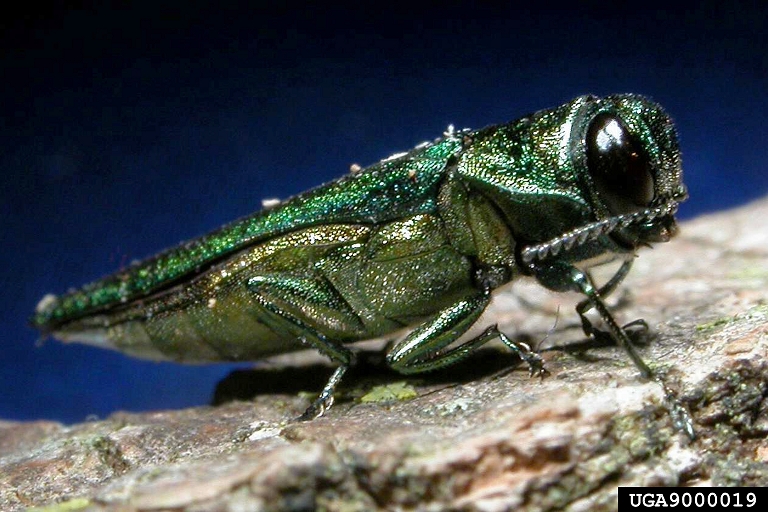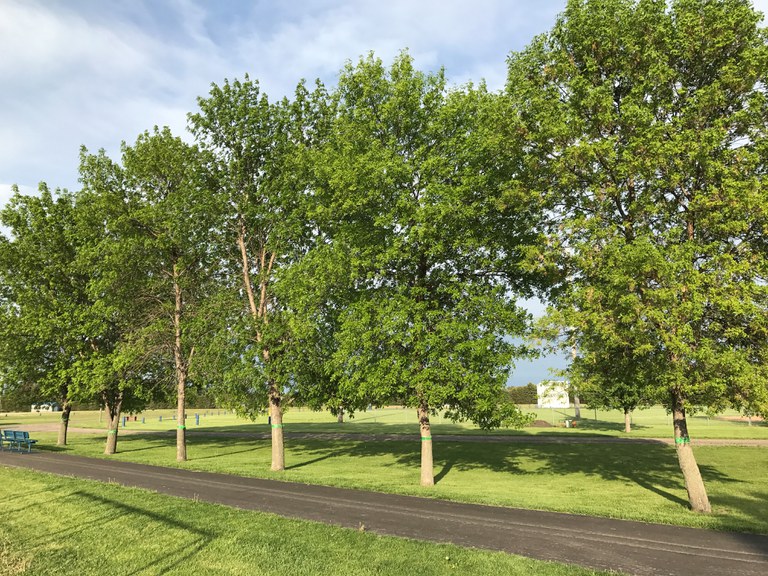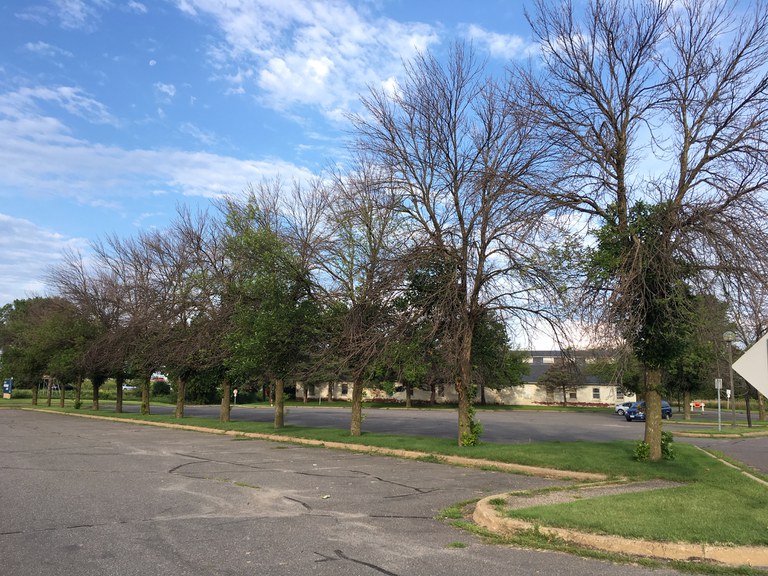What Happens if EAB Comes to Your Town?
For years now, we have been warned that emerald ash borer (EAB) is a threat to North Dakota ash trees. Since its 2002 discovery in Detroit, EAB has continued to spread across North America and toward us, killing millions of ash trees. EAB is established and is destroying ash trees in neighboring Minnesota, South Dakota and Winnipeg, Manitoba (see the map at www.emeraldashborer.info). Although EAB has NOT been detected in North Dakota (as of the time of this writing), its arrival in ND is inevitable. It will spread in a sporadic fashion – it will not engulf the state all at once. But all ash trees are at risk and the costs in North Dakota will be devastating.
 Adult Emerald Ash Borer. The immature or larval stage of this pest tunnels into the trunk and branches of ash trees, cutting off the flow of water, nutrients and sugars under the bark and killing the tree in a few years.” Photo credit: David Cappaert, Bugwood.org
Adult Emerald Ash Borer. The immature or larval stage of this pest tunnels into the trunk and branches of ash trees, cutting off the flow of water, nutrients and sugars under the bark and killing the tree in a few years.” Photo credit: David Cappaert, Bugwood.org
What Can You do to Prepare?
Be aware of your tree inventory. The ND Forest Service has completed street tree inventories in more than a hundred communities, visible for viewing on the ND TIP Tool website, http://ndcitytrees.org. Click on the ‘Explore Cities’ button to find your town. Public trees will show up as dots, color-coded to show different types of trees. In nearly all ND communities, ash trees (this includes all cultivars of green ash and black ash) dominate streets and the landscape. ON PRIVATE PROPERTY: Note the ash trees in your yard and in windbreaks and shelterbelts. Are they important for shade? Wind protection? Wildlife habitat? These valuable trees may someday be gone, thanks to EAB.
 Many streets in North Dakota communities are lined with green ash trees like these in Milnor. Photo credit: Mary O’Neill, North Dakota Forest Service
Many streets in North Dakota communities are lined with green ash trees like these in Milnor. Photo credit: Mary O’Neill, North Dakota Forest Service
Remove trees that are in decline. Communities can view their inventory to identify unhealthy trees. Remove them ASAP, especially ash trees, to make your streets safer, more beautiful, and to open planting spaces for a variety of new trees. Many ash trees are in decline due to physical stresses and native pest problems that attack stressed trees.
 Dead and dying green ash in Fort Snelling, Minnesota. Streets In North Dakota may someday look the same.” Photo credit: Ralph Sievert, Minneapolis Park and Recreation Board Forestry Department.
Dead and dying green ash in Fort Snelling, Minnesota. Streets In North Dakota may someday look the same.” Photo credit: Ralph Sievert, Minneapolis Park and Recreation Board Forestry Department.
Plant a variety of new trees. Diversity of trees will limit the impact of any pest or disease. Choose the right tree for the site – for open spaces, plant larger statured trees like lindens, hackberry, Kentucky coffeetree and Dutch elm disease resistant-elms. Medium-size trees include Ohio buckeye and honeylocust. For narrow boulevards and areas near overhead wires, choose smaller-size trees like flowering crab, Amur maple and Japanese tree lilac.
Don’t Move Firewood. The most common way for invasive pests to spread is through the transport of firewood. Burn harvested wood locally, or buy it where you plan to burn it. Don’t move firewood!
Contact ND Forest Service for assistance. For communities, NDFS Community Forestry cost-share grants are available for tree removals and for planting trees on public property. Rural landowners can receive technical assistance to evaluate existing plantings and develop a management plan.
For more information on community tree inventories, tree selection, or community forestry grants, contact NDFS Community Forestry staff:
Gerri Makay (Carrington) Gerri.Makay@ndsu.edu
Mary O’Neill (Lisbon) Mary.Oneill@ndsu.edu
Beth Hill (Bismarck) Beth.Hill@ndsu.edu
For questions about windbreak assessments, contact NDFS Forest Stewardship Manager
Liz Smith Liz.Smith@ndsu.edu
Gerri Makay
Gerri.Makay@ndsu.edu
Community Forestry Manager


